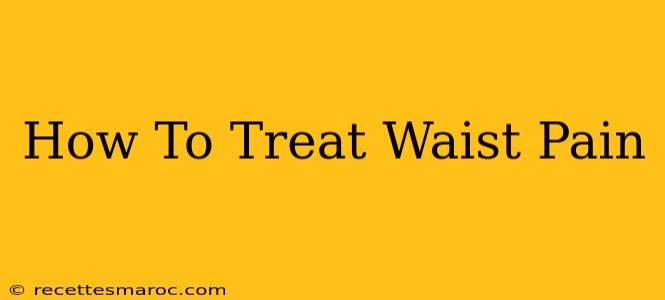Waist pain, that nagging ache in your lower back, is a common complaint affecting people of all ages. It can stem from a variety of causes, from minor muscle strains to more serious conditions. This comprehensive guide explores effective ways to treat waist pain, focusing on both at-home remedies and when to seek professional medical attention.
Understanding the Causes of Waist Pain
Before diving into treatment, it's crucial to understand the potential root causes of your waist pain. This will help determine the most appropriate course of action. Common causes include:
- Muscle strains and sprains: These are often caused by sudden movements, lifting heavy objects improperly, or overuse.
- Disc problems: Herniated or bulging discs can put pressure on nerves, causing pain that radiates down the leg (sciatica).
- Arthritis: Osteoarthritis and other forms of arthritis can inflame the joints in your lower back, leading to persistent pain and stiffness.
- Spinal stenosis: Narrowing of the spinal canal can compress the nerves, causing pain, numbness, and weakness.
- Stress fractures: These tiny cracks in the bones of the spine are more common in athletes or individuals with osteoporosis.
- Fibromyalgia: This chronic condition causes widespread muscle pain, fatigue, and sleep disturbances.
- Kidney infections or stones: In some cases, waist pain can be a symptom of a kidney problem.
At-Home Treatments for Waist Pain
Many cases of waist pain can be effectively managed at home with conservative treatments. These include:
1. Rest and Ice:
Resting your back allows the injured tissues to heal. Avoid activities that aggravate your pain. Apply ice packs for 15-20 minutes at a time, several times a day, during the initial 48-72 hours to reduce inflammation.
2. Over-the-Counter Pain Relief:
Nonsteroidal anti-inflammatory drugs (NSAIDs) like ibuprofen or naproxen can help reduce pain and inflammation. Always follow the recommended dosage instructions.
3. Heat Therapy:
After the initial 48-72 hours, heat therapy can help relax muscles and ease stiffness. Use a heating pad or take a warm bath or shower.
4. Gentle Stretching and Exercise:
Once the acute pain subsides, gentle stretching and low-impact exercises can help strengthen your back muscles and improve flexibility. Examples include walking, swimming, and yoga. Avoid strenuous activities.
5. Good Posture:
Maintaining good posture throughout the day is crucial for preventing and managing waist pain. Sit with your back straight, and avoid slouching. When lifting heavy objects, bend your knees and lift with your legs, not your back.
6. Ergonomic Adjustments:
Evaluate your workstation and make necessary adjustments to ensure proper support for your back. This might involve using a supportive chair, adjusting your monitor height, and taking regular breaks.
When to Seek Professional Medical Attention
While many cases of waist pain resolve with home treatment, it's important to seek professional medical attention if:
- Your pain is severe or doesn't improve after a few weeks of home treatment.
- Your pain radiates down your leg(s) and is accompanied by numbness or weakness.
- You experience bowel or bladder problems.
- You have a fever or unexplained weight loss.
- You have a history of cancer or osteoporosis.
Your doctor can perform a physical examination, order imaging tests (such as X-rays or MRIs), and recommend appropriate treatment based on the underlying cause of your waist pain. This might include physical therapy, medications, injections, or in rare cases, surgery.
Preventing Waist Pain
Preventing waist pain involves a holistic approach encompassing lifestyle modifications and proactive measures:
- Maintain a healthy weight: Excess weight puts extra strain on your back.
- Strengthen your core muscles: A strong core provides support for your spine.
- Practice good posture: This is crucial in minimizing strain on your back.
- Ergonomic workplace setup: Ensure your workspace promotes proper posture and minimizes strain.
- Regular exercise: Engage in activities that strengthen your back and core muscles.
- Quit smoking: Smoking negatively impacts bone health and slows healing.
By understanding the causes of waist pain, employing effective home treatments, and knowing when to seek professional help, you can effectively manage your pain and improve your overall quality of life. Remember, prevention is key, so adopting healthy lifestyle choices is crucial in minimizing the risk of future episodes.

